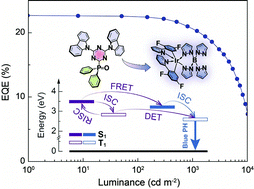A ternary phosphine oxide host featuring thermally activated delayed fluorescence for blue PHOLEDs with >20% EQE and extremely low roll-offs†
Abstract
Development of high-performance blue organic light-emitting diodes (OLEDs) is one of the main challenges because efficient host-dopant energy transfer is necessary to develop highly efficient OLEDs. In this study, an effective molecular design strategy for blue phosphorescent hosts with high triplet (T1) energy and the feature of thermally activated delayed fluorescence (TADF) has been demonstrated using a ternary donor–acceptor–acceptor (D–A–A) molecule, DCDPOTZ, in which carbazole, triazine and diphenylphosphine oxide are incorporated as donor and acceptors. DCDPOTZ achieves the typical characteristics of TADF with a high T1 energy level of 2.93 eV and a small singlet–triplet splitting of 0.27 eV, accompanied by the ambipolar property. Its host characteristics are further improved by its diphenylphosphine oxide group with large steric hindrance for suppressing intermolecular interaction-induced quenching. By adopting bis(4,6-difluorophenylpyridinato)tetrakis((1-pyrazolyl)borate)iridium(III) (FIr6) as a dopant, DCDPOTZ successfully realizes 100% host-dopant energy transfer efficiency. As a consequence, DCDPOTZ endowed its FIr6-based devices with extremely low driving voltages, the state-of-the-art external quantum efficiency (EQE) of up to 22.7%, and 100% internal quantum efficiency. At 1000 nits, the EQE is still beyond 20%, corresponding to a roll-off as low as 11%, which is one of the lowest values reported to date for blue phosphorescent OLEDs.



 Please wait while we load your content...
Please wait while we load your content...